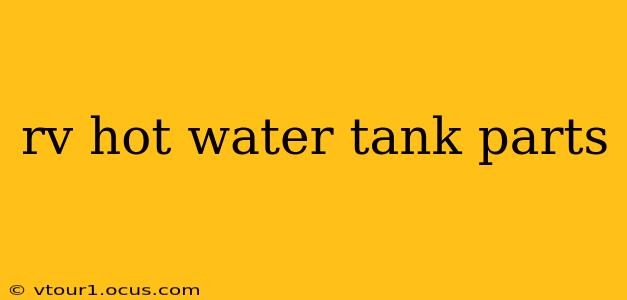Maintaining your RV's hot water system is crucial for comfortable camping. Understanding the different RV hot water tank parts and how they function can save you from unexpected cold showers and costly repairs. This guide provides a detailed overview of common components, troubleshooting tips, and maintenance advice to keep your hot water flowing smoothly.
What are the main components of an RV hot water tank?
An RV hot water tank, while smaller than its residential counterpart, comprises several essential parts working in harmony. These include:
- Tank: The pressure vessel itself, typically made of durable materials like stainless steel or aluminum, holding the water. Size varies depending on the RV, typically ranging from 6 to 10 gallons.
- Heating Element(s): Electric or gas-powered elements responsible for heating the water. Electric tanks use one or two heating elements, while gas tanks utilize a burner. Understanding your heating element type is vital for troubleshooting.
- Thermostat: This crucial component regulates the water temperature, preventing overheating and ensuring consistent hot water. A faulty thermostat is a common cause of malfunction.
- Pressure Relief Valve: A safety device that releases excess pressure to prevent tank rupture. Regular inspection and testing are essential.
- Drain Valve: Allows for draining the tank for cleaning, maintenance, or winterizing.
- Anode Rod (Sacrificial Anode): This rod protects the tank's interior from corrosion. It dissolves over time, requiring periodic replacement.
- Water Inlet Valve: Controls the flow of cold water into the tank.
- Dip Tube: This directs cold water to the bottom of the tank, allowing for more efficient heating. A clogged dip tube can hinder performance.
How do I know if my RV hot water tank needs repair?
Several signs indicate that your RV hot water tank might need attention:
- No Hot Water: This is the most obvious sign, potentially indicating a faulty heating element, thermostat, or gas supply issue (for gas-powered tanks).
- Leaking Tank: A leak suggests a compromised tank, pressure relief valve issue, or loose fittings. This requires immediate attention to prevent further damage.
- Rusty Water: This points to a corroding tank or a failing anode rod. Replacing the anode rod is often the solution.
- Inconsistent Water Temperature: A malfunctioning thermostat is the likely culprit.
- Strange Noises: Unusual gurgling or banging sounds might indicate sediment buildup or a problem with the heating element.
What are the common RV hot water tank problems and how can I fix them?
Many issues can be resolved with basic DIY skills. However, if you are unsure about any repair, consult a qualified RV technician.
H2: My RV hot water heater isn't heating the water. What could be wrong?
This is a common problem with several potential causes. First, check your power source (for electric heaters) or gas supply (for gas heaters). Then, inspect the heating element(s) and thermostat for proper function. A multimeter can help test the heating element's continuity. A faulty thermostat needs replacement.
H2: My RV hot water heater is leaking. What should I do?
A leak is a serious issue. First, locate the source. It could be a cracked tank (requiring replacement), a faulty pressure relief valve, or loose fittings. Tighten any loose connections; however, a cracked tank will need professional repair or replacement.
H2: How often should I replace my RV hot water tank anode rod?
The lifespan of an anode rod depends on usage and water quality. It's generally recommended to inspect and replace it every 1-2 years. A heavily corroded anode rod indicates it’s time for replacement.
H2: How do I winterize my RV hot water tank?
Proper winterizing is essential to prevent freeze damage. This involves completely draining the tank, adding RV antifreeze through the water inlet, and running the water lines to ensure antifreeze reaches all components. Consult your RV's manual for specific instructions.
Conclusion:
Regular maintenance and understanding the components of your RV hot water tank are crucial for a trouble-free camping experience. By addressing issues promptly and performing routine checks, you can extend the life of your system and avoid unexpected breakdowns. Remember that safety should always be your priority. If you are uncomfortable performing repairs yourself, always consult a qualified professional.
